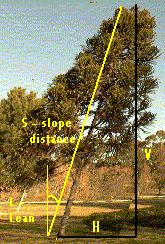
Forest Measurement and Modelling.
 |
Total height of a single tree Forest Measurement and Modelling. |
     |
|
|
|
Total height is a very important tree variable. The total height (or potential height) of a woody plant is used to distinguish shrubs from trees. Specht (1970) for example, defines a tree as a woody plant, usually with a single stem, that is more than 5 m tall. Tree height is well correlated with other important tree and stand parameters.
Thus, total tree height is often measured to provide quantitative information about a tree as well as qualitative information about the area. |
|
| Definition |
Total tree height may be defined as the distance along the axis of the bole of the tree from the ground to the uppermost point (tip). In trees with a single, straight stem, this corresponds to the total length of the stem. On leaning trees, height may also expressed as the:
On leaning trees, height may also expressed as the:
The linear component will always be greater than the vertical component for leaning trees. However, unless the lean is severe, the difference is rarely critical. The tree must be leaning by more than 18 degrees off vertical before the difference exceeds 5%. A lean in excess of 15 degrees looks severe. The vertical component (V) can be calculated from the slope (S) height (and visa-versa) if the horizontal distance (H) from the base of the tree to the point directly beneath the tip is known. S= 
|
|
Tree habit Excurrent Deliquescent |
 Total height is most easily measured on trees
with a well-defined tip - trees with an excurrent
habit. Most conifers and many young trees are in
this group.
Total height is most easily measured on trees
with a well-defined tip - trees with an excurrent
habit. Most conifers and many young trees are in
this group.Trees with a spreading or rounded crown without a clearly defined tip have a deliquescent habit. Location of the uppermost point is more difficult in these types of trees. To locate the tip of a deliquescent tree, extend a line along the axis of the bole until it is judged to meet the crown surface. |

|
[totalhgt.htm] Revision: 6/1999 |